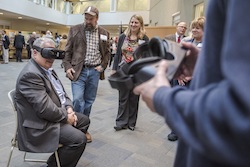
CHSP Dean Randy Leite takes a trip through virtual reality
Demonstrating emerging technologies and innovative ideas in the fields of patient care, research and education, the Biomedical Technology Showcase on Thursday, Feb. 15, featured more than two dozen exciting exhibits.
The showcase was held in Ohio University’s Grover Center Atrium and hosted by the College of Health Sciences and Professions with collaborative support from the Office of Vice President for Research and the Heritage College of Osteopathic Medicine.
“The biomedical showcase was a wonderful opportunity to see some incredibly exciting and innovative work going on at Ohio University and among external partners in the region,” said Randy Leite, dean of the College of Health Sciences and Professions. “It was so exciting to see the many cutting-edge projects being done by our faculty and students. The showcase really pointed out that they are making a difference every day in the work that they do.”
Quidel Corporation demonstrated Sofia and Solana, two state-of-the-art testing machines. Sofia provides rapid testing for influenza A+B and RSV through the use of two bench top analyzers. Sofia is able to produce and store results in as few as three minutes and test kits are easy to use. Solana is a simplified molecular testing platform capable of testing up to 12 tests at a time and determining the presence of influenza, adenovirus, RSV, strep and more.
At another booth, Dr. Sherleena Buchman and Dr. Deborah Henderson, from the School of Nursing, in partnership with John Bowditch and Eric Williams, from the Scripps College of Communication, exhibited a research project that brought students from a CHSP interprofessional course over to Scripps for a virtual reality experience.
Students from seven different professions were immersed in a virtual patient 360 Video encounter as Alfred©. They became a patient with macular degeneration and progressive hearing loss. Through these experiences, students took on the persona of Alfred© and reported back to the research team through focus groups that the use of virtual reality as a learning tool enhanced their learning. The students said interface made them feel as if they were the patient during the experience and they expressed increased levels of understanding of the disease process and interest in future learning activities involving virtual reality.
Some of the youngest scientists in attendance were Alexander High School seniors Justin Rollins and Hadley Hibbard, under the tutelage of their science teacher, Dan Hendershott. The duo is backed by Kids on Campus which helps fund and provide materials for Rollins’ and Hibbard’s inventions. They showed off a hovercraft they will enter into a regional and statewide Science Olympiad competition and explained their challenge of having to have the device traverse two meters of an unknown surface in precisely 15 seconds while carrying a number of rolls of pennies. Last year, a robot arm developed by the two won regionals and placed eighth in state.
